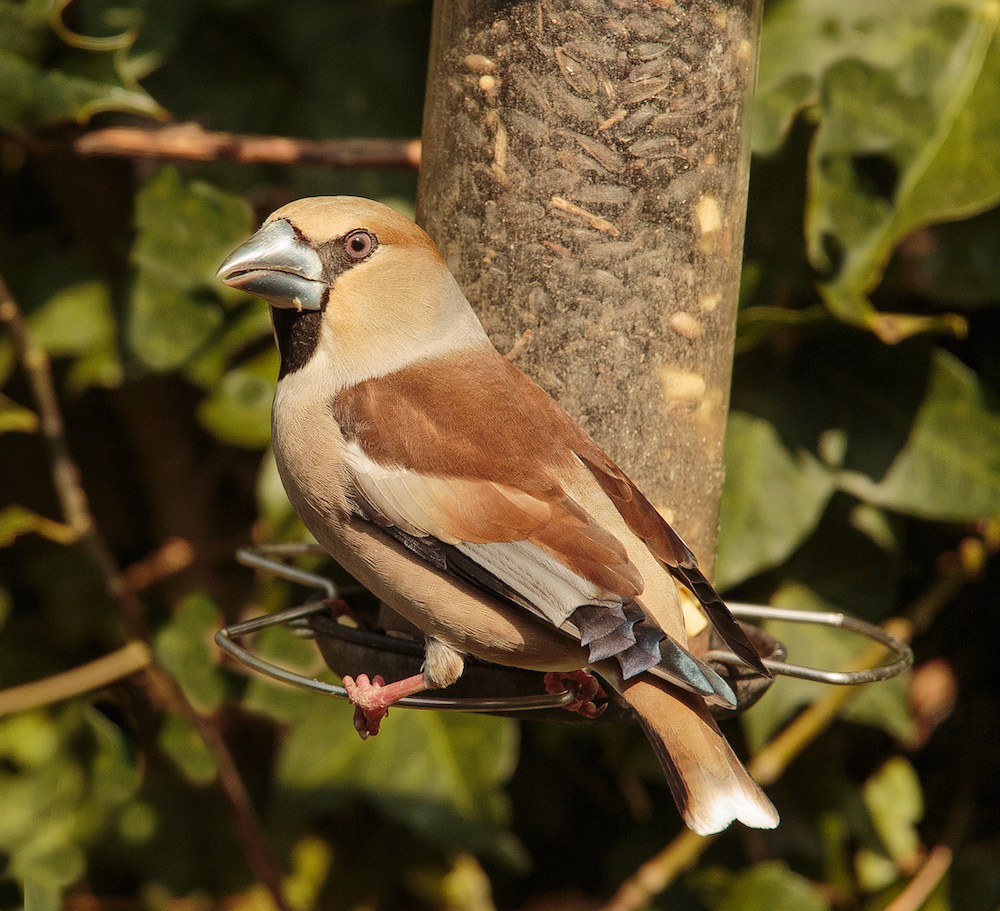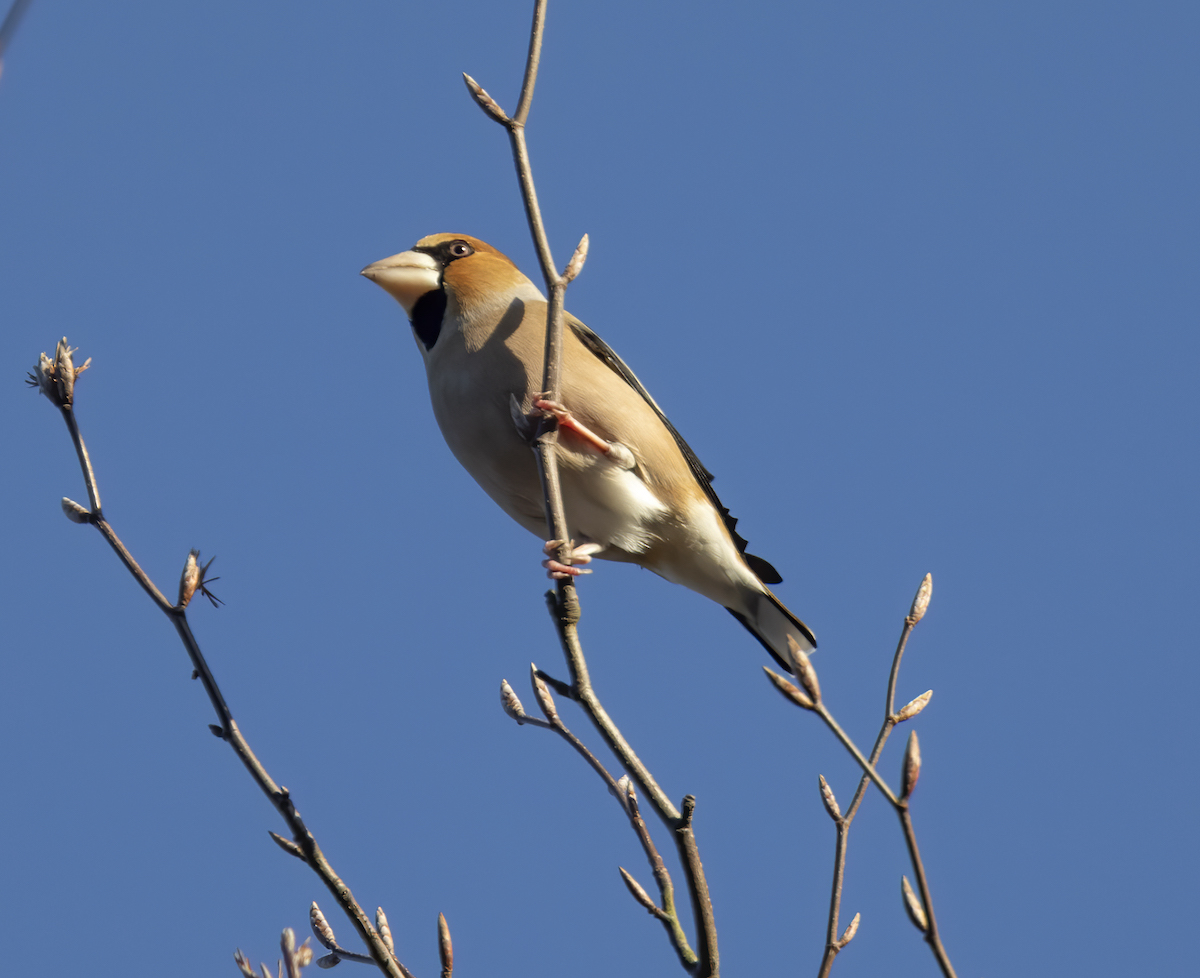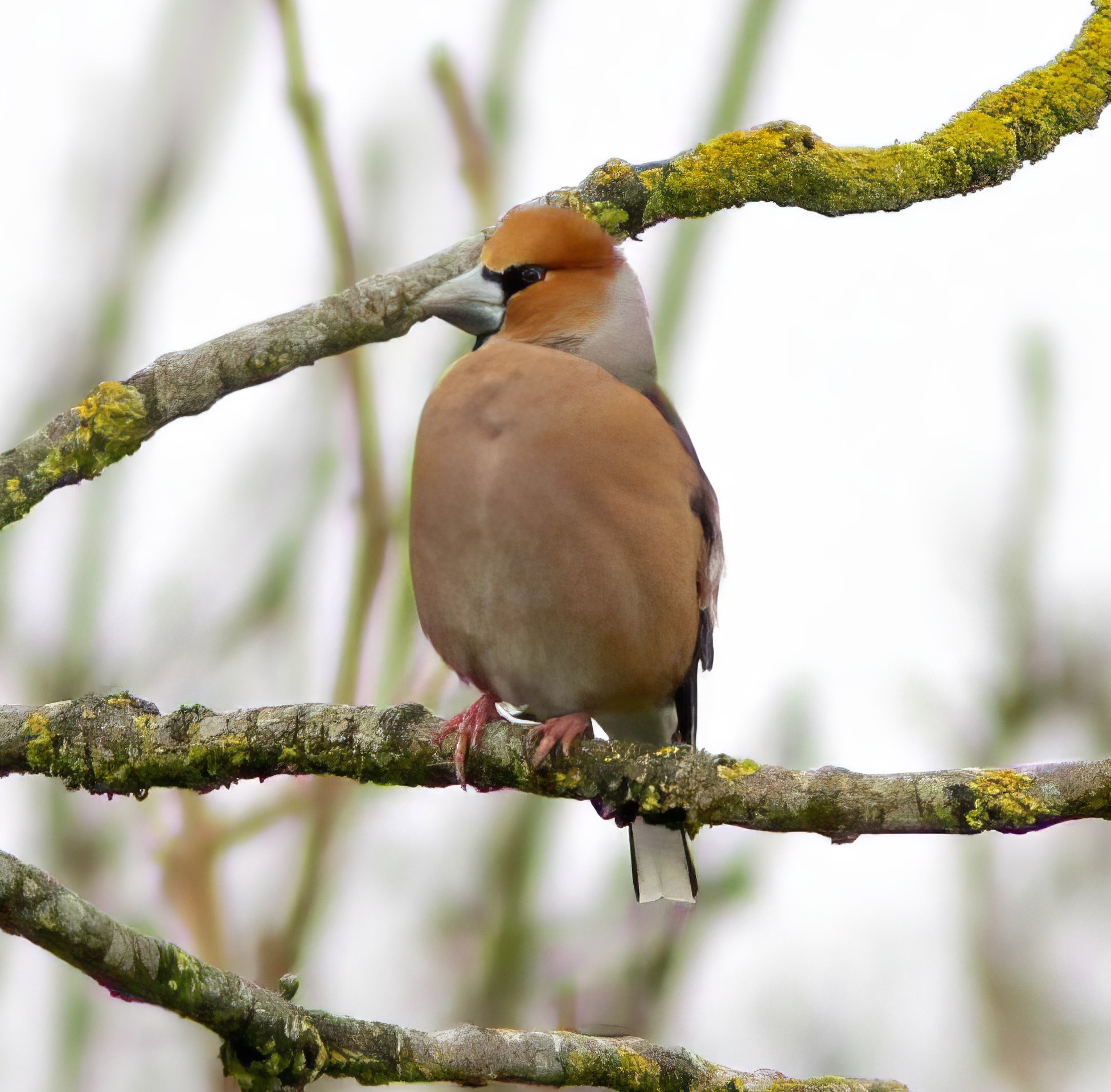Hawfinch Coccothraustes coccothraustes
Formerly a very scarce breeding species, now a rare passage migrant and winter visitor. Occasionally irruptive.
Migrant Hawfinches: left, in a Saltfleetby garden April 9th 2015 (Mike Tarrant); centre, Broughton November 26th 2017 (Graham Catley);
right, East Keal churchyard March 27th 2018 (Phil Hyde)
Smith & Cornwallis (1955) described the Hawfinch as a scarce resident in most well-wooded districts but also noted two coastal records in the early 1950s. L&A also called it a scarce and local resident of the more extensive areas of deciduous woodland, while noting that it was under-recorded because of its secretive nature. They formerly bred in the north-west of the county in the woods around Scunthorpe with the last confirmed breeding taking place in 1999. By 1988, there had been 23 coastal records, chiefly single birds, of which seven were during April-June and the remainder from late July to January. Annual totals to 2016 are shown in the chart below. Spring flocks of around 20 birds continued to be seen in the Scawby area up until the mid 2000s but there has been no further evidence of breeding. Over the last 10 years it has become increasingly very scarce. LBR for the five years to 2018 reports the maximum number of birds in spring ranged from zero in 2014 and 2017 to four in 2018, with one in 2015 and 2016. Autumn passage was also very light with most birds seen on the coast and numbers ranging from three in 2014 and 2015 and eight in 2016 and 2018. However, momentous events occurred in the UK and Lincolnshire in 2017-18 when record numbers arrived (see below).
The origin of coastal migrants is not clear. It is possible that they could be dispersing from British breeding areas but there are a few ringing recoveries between Britain and continental Europe, especially Norway (Robinson et al. 2017), which suggest that some breeding birds from there migrate through or perhaps winter in Britain. There has been only one Hawfinch recovery involving Lincolnshire: a bird ringed in Shetland in October 2008 was found, long dead, at Holbeach in February 2009. This may well have been a continental bird.
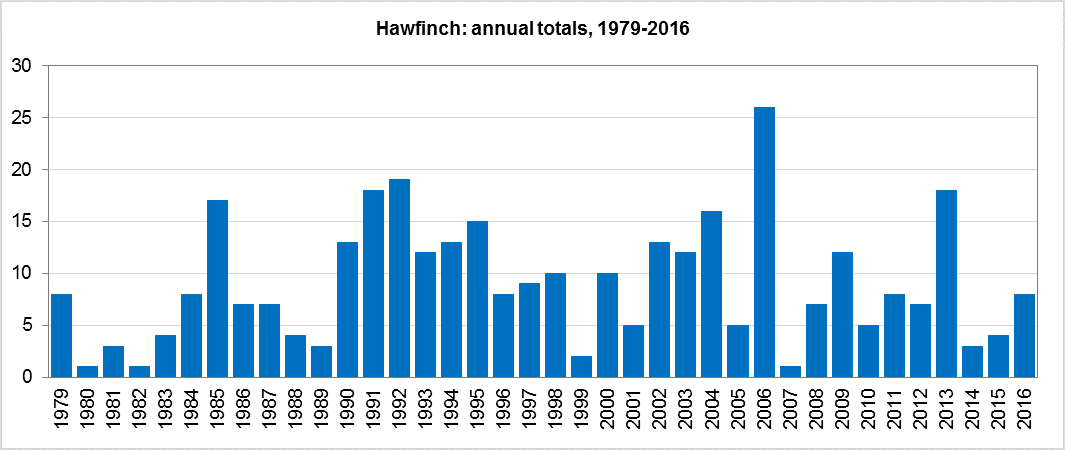
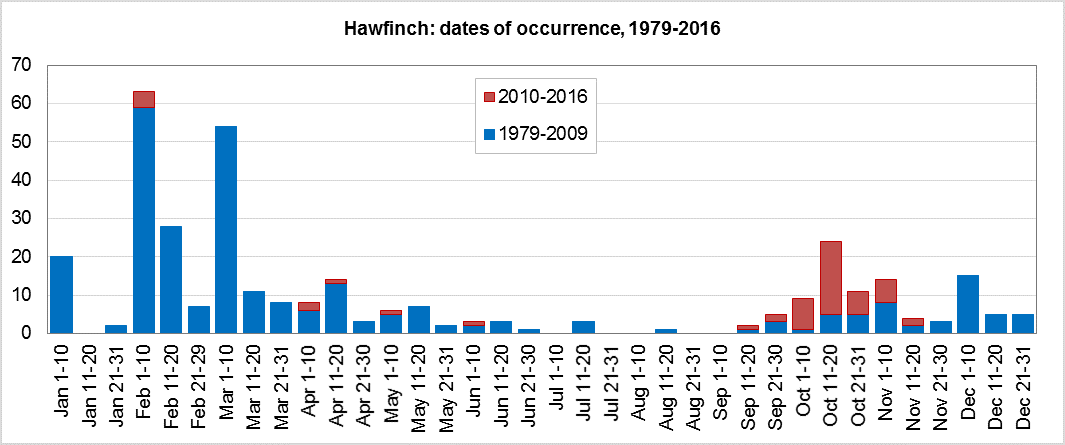
The invasion of Hawfinches Coccothraustes coccothraustes in Lincolnshire in 2017-2018.
by P. A. Hyde
Note: this account is based on the article which appeared in the Lincolnshire Bird Report 2018.
Introduction
One of the biggest surprises of autumn 2017 was the unprecedented arrival of Hawfinches into Britain. The exact number is difficult to calculate as the birds were so widespread and mobile, but it is thought that in excess of 1,000 birds arrived here and that the true figure might even have been as high as 5,000. The estimated UK breeding population is only 500–1,000 pairs, so this is an incredible increase. Some of the largest concentrations were in Surrey, Sussex and Shropshire. Hawfinches began arriving from the second week of October 2017. In the southern half of the country one of the largest counts was of 115 over Step’s Hill, Buckinghamshire, during the morning of October 23rd. Elsewhere in England the BirdGuides (BG) Review of the Week, 25th-31st October, noted that there were 630+ reports during this week (compared to 323 the previous week), with several 1,000s of birds having arrived. The BG map for 25th-31st October showed that the greatest density occurred in a dense band running northwest through the Midlands, from Kent and Sussex to Lancashire.
Conditions in continental Europe in 2016 and 2017
The name Hawfinch suggests that Hawthorn Crataegus monogyna berries are a favourite food but, although they do form part of their diet, they prefer Yew Taxus baccata, Hornbeam Carpinus betulus and Field Maple Acer campestre. Irruptions are typically associated with a failure of this food supply: too many birds, or not enough food for them to survive the winter. A preliminary summary in the journal Der Falke, which compared data in 2017 with that of the three-year period 2014-2016, showed that records submitted to the German online portal Ornitho.de in 2017 were more frequent than usual from August and peaked in October and were thought to reflect Hawfinch movements due to an almost complete failure of the Beech Fagus sylvatica crop, which was known to have occurred in at least northwestern Germany if not elsewhere in central and eastern Europe. In addition, in the western German state of North Rhine-Westphalia there was a bumper seed crop of both Beech and Hornbeam in 2016, followed by an almost total failure of both in 2017. Frosts in late April 2017 also affected the yields of commercial fruit trees, including cherries Prunus, and thus almost certainly wild cherries too. It is therefore likely that the Hawfinchpopulation was high following the abundance of food in 2016, and that the almost total lack of Beech mast, Hornbeam nuts and Cherry stones in 2017 accounted for the 2017 irruption, with birds moved south and west in search of food (per P. Combridge). In Lincolnshire birds were observed very often feeding on Yew berries, but also on tree leaf buds such as Beech and Sycamore Acer pseudoplatanus (pers. obs.).
Hawfinch migration in Western Europe in 2017
The weather has been mooted as a factor in the Hawfinch invasion but probably had less of an impact than failure of their food supply. Hawfinches traditionally migrate south from their breeding grounds in Central Europe towards the Mediterranean. In 2017 their migration coincided with the arrival of Storm Ophelia, which headed eastwards from the Atlantic, swirling anticlockwise off the west coast of Europe, and the strong winds could have pushed migrating Hawfinches towards the UK. However, this is harder to prove. Considerable numbers of Hawfinches were seen in France in October 2017, with most at the migration watch point of La Cotentin, Plangenoual (Brittany), where 3,548 were recorded during the period Oct 15th-31st, peaking at 1,352 on Oct 24th. In November the numbers tailed off, with ‘just’ 823 seen between Nov 1st-9th. In Holland and Belgium there were lower counts in October, with peak day counts of 266 at De Vulkaan (Den Haag, Netherlands) on Oct 16th and 143 at Zandpanne De Haan (West Flanders, Belgium) on Oct 26th (data courtesy of www.trektellen.org). The direction of the irruption was mainly to the southwest. In contrast, further north at Falsterbo, Sweden, for example, a below average number of Hawfinches (5) was seen in October 2017 (https://www.falsterbofagelstation.se/index_e.html) compared to 34 in October 2018.
Hawfinches in Lincolnshire, 2017-18.
Lincolnshire saw unprecedented numbers arrive from mid-October with two at Gibraltar Point on October 14th, 2017 (Hyde 2018) and the arrivals continued throughout the later autumn and winter. The autumn peak was 32 birds across 14 sites in November with Forest Pines, Broughton having 10 birds in November and 21 in December. Wintering numbers across the county increased to a peak of 110 in the week February 21st-27th 2018, with 60 at Forest Pines. Elsewhere Scawby Park had 32 on January 31st and East Keal churchyard had 24 on April 8th. Even at the beginning of April there were still 81 birds across the county. By April 25th they had all departed, presumably to south-eastern Europe from whence it is thought they came. In October 2020 a colour ringed bird was photographed at Saltfleetby-Theddlethorpe Dunes NNR. It had been ringed in the Conway Valley of North Wales in February 2018. It was thought by the ringer to be a Scandinavian wintering bird because of its size and weight.
The chart (below) groups the total numbers of Hawfinches reported to the LBC by seven-day periods from October 2017 – April 2018. Perusal of the LBC archive showed that numbers petered out by mid-April 2018 and the last were three at Gibraltar Point on Apr 19th. (There were also two there on May 25th, one May 29th-30th and one Jun 1st, possibly all relating to the same one or two individuals. Given the gap between these records and the last in mid-April these were not considered to be part of the departing 'invasion' birds).
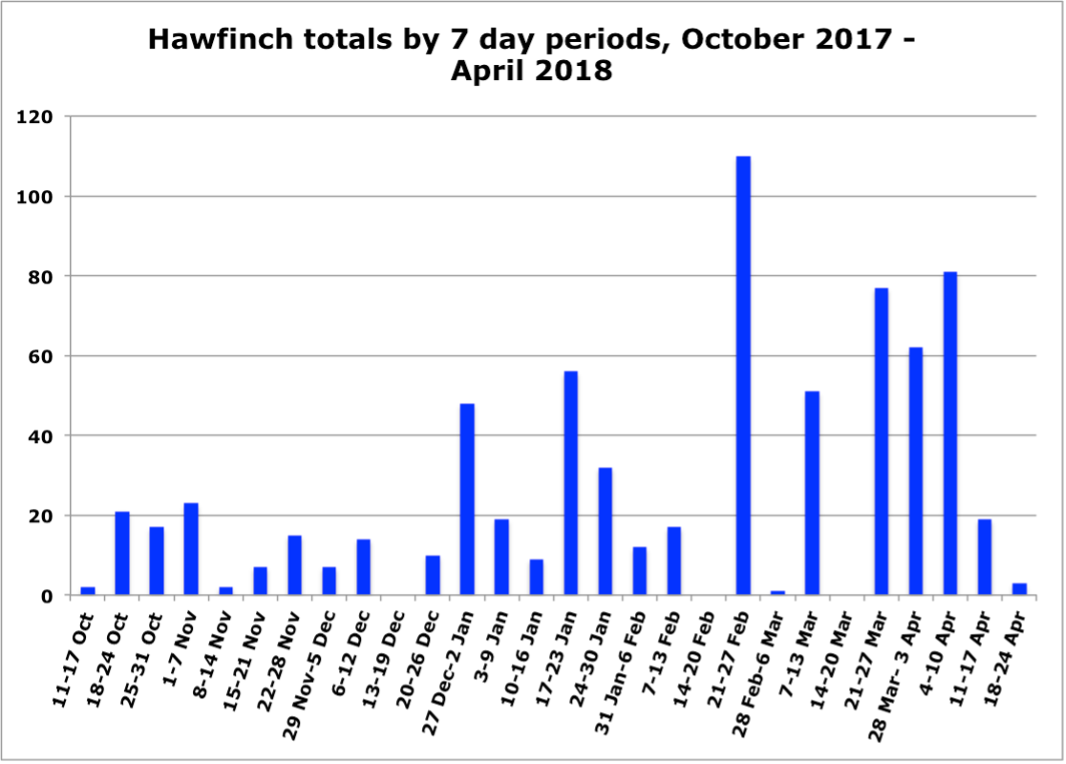
References
- Balmer, D.E., Gillings, S., Caffrey, B.J., Swann, R.L., Downie I.S. and Fuller, R.J. (2013) Bird Atlas 2007-11: the breeding and wintering birds of Britain and Ireland. BTO books, Thetford.
- Clements, R. (2013) A UK population estimate for the Hawfinch. British Birds 106: 43-44.
- Eaton, M.A., Aebischer, N. J., Brown, A. F., Hearn, R. D., Lock, L., Musgrove, A. J., Noble, D. G., Stroud, D.A., and Gregory, R. D. (2009) Birds of Conservation Concern 4: the population status of birds in the United Kingdom, Channel Islands and Isle of Man. British Birds 108: 708-746.
- Gibbons, D.W., Reid, J.B. & Chapman, R.A. (1993) The New Atlas of Breeding Birds in Britain and Ireland. T. & A.D.Poyser, London.
- Hyde, P.A. (2018). The invasion of Hawfinches Coccothraustes coccothraustes in Lincolnshire in 2017-2018. Lincolnshire Bird Report 2018. ISBN 0261-5525.
- Robinson, R.A., Leech, D.I. & Clark, J.A. (2017) The Online Demography Report: Bird ringing and nest recording in Britain & Ireland in 2016. BTO, Thetford (http://www.bto.org/ringing-report, created on 5-September-2017)
- Sharrock, J.T.R. (1976) The Atlas of Breeding Birds in Britain and Ireland. T. & A.D.Poyser, London
- Smith, A.E. and Cornwallis, R.K. (1955) The Birds of Lincolnshire. Lincolnshire Naturalists’ Union, Lincoln.
(Account prepared October 2017; updated with reference to the new Birds of Lincolnshire (2021) December 2022)


